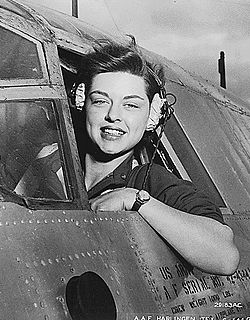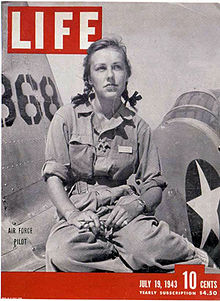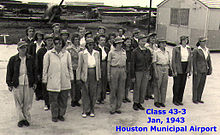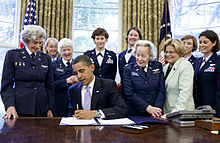- Women Airforce Service Pilots
-
The Women Airforce Service Pilots (WASP) and its predecessor groups the Women's Flying Training Detachment (WFTD) and the Women's Auxiliary Ferrying Squadron (WAFS) (from September 10, 1942) were pioneering organizations of civilian female pilots employed to fly military aircraft under the direction of the United States Army Air Forces during World War II. The WFTD and WAFS were combined on August 5, 1943, to create the paramilitary WASP organization. The female pilots of the WASP would end up numbering 1,074, each freeing a male pilot for combat service and duties. The WASP flew over 60 million miles in all, in every type of military aircraft.[1] WASPs were granted veteran status in 1977, and given the Congressional Gold Medal in 2009.[2]
Twenty-five thousand women applied to join the WASP, but only 1,830 were accepted and took the oath, and out of those only 1,074 women passed the training and joined.[1][3]
Contents
Creation of the WASP
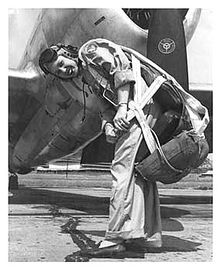 Deanie Parish in front of P-47 Thunderbolt on the flight line at Tyndall Air Force Base, Florida, in 1944
Deanie Parish in front of P-47 Thunderbolt on the flight line at Tyndall Air Force Base, Florida, in 1944
By the summer of 1941, the famous women pilots Jacqueline "Jackie" Cochran and test-pilot Nancy Harkness Love independently submitted proposals for the use of female pilots in non-combat missions to the US Army Air Forces (USAAF, the predecessor to the United States Air Force or USAF) after the outbreak of World War II in Europe.[4] The motivation was to free male pilots for combat roles by employing qualified female pilots on missions such as ferrying aircraft from factories to military bases, and towing drones and aerial targets. Leading into Pearl Harbor, General Henry H. "Hap" Arnold, commander of the USAAF, had turned down both Love's 1940 proposal and the proposal of the better connected and more famous Cochran despite unsubtle lobbying by Eleanor Roosevelt, but essentially promised command of any such effort to Cochran, should such a force be needed in the future.
While the U.S. was not yet fighting in the war, Cochran had gone to England to volunteer to fly for the Air Transport Auxiliary (ATA).[5] The ATA had been using female pilots since January 1940 and was starting to train new ones as well. The American women who flew in the ATA were the first American women to fly military aircraft.[5] They flew the Royal Air Force's front-line aircraft—Spitfires, Typhoons, Hudsons, Mitchells, Blenheims, Oxfords, Walruses, and Sea Otters—in a non-combat role, but in combat-like conditions. Most of these women served the war in the ATA. In fact, only three members of the ATA returned to the U.S. to participate in the WASP program.
The U.S. was building its air power and military presence in anticipation of direct involvement in the conflict and had belatedly begun to drastically expand its men in uniform. This period had led to a dramatic increase in activity for the U.S. Army Air Forces, and there were obvious gaps in "manpower" that could be filled by women. However, it was not until after the attack on Pearl Harbor brought U.S. armed forces into the war that it became evident there were not enough male pilots.
To those most involved within the USAAF, especially in the new Ferrying Division of the Air Transport Command (ATC), the numbers were painfully obvious. Ferrying Division commander Brig. Gen. William H. Tunner, in charge of acquiring civilian ferry pilots, decided to integrate a civilian force of female pilots into the AAF after speaking with a fellow ATC staff officer, Major Robert M. Love and his wife Nancy. Convinced of the feasibility of the program by Mrs. Love, who had a Commercial Pilot Licence, he asked her to draw up a proposal, unaware that Arnold had shelved a similar proposal by Tunner's superior, Maj. Gen. Robert Olds.
Cochran had committed to go to Great Britain in March 1942 for a trial program of female pilots with the ATA, and used her association with President and Mrs. Roosevelt to lobby Arnold to reject any plan that did not commission women and set up an independent organization commanded by women. Ironically, Tunner's proposal called for commissioning women in the WAACs, which was turned down after review by Arnold.
By mid-summer of 1942, Arnold was willing to consider the prior proposals seriously. Tunner and Love's plan was reviewed by ATC headquarters, and forwarded by now-commander Gen. Harold L. George to Arnold, who was fully aware of it and gave it his blessing after Mrs. Roosevelt suggested a similar idea in a newspaper column. The Women's Auxiliary Ferry Squadron (WAFS), headed by Mrs. Love, went into operation on September 10, 1942. Soon the Air Transport Command began using women to ferry planes from factory to air fields.
Cochran returned to the United States on September 10 as the new organization was being publicized, and immediately confronted Arnold for an explanation. Arnold claimed ignorance and blamed the ATC staff, in particular George's chief of staff, Col. (and former president of American Airlines) C. R. Smith. With the publicity involved, the WAFS program could not be reversed, and so on September 15 Cochran's training proposal was also adopted. Cochran and Love's squadrons were thereby established separately: as the 319th Women’s Flying Training Detachment (WFTD) at Municipal Airport (now Hobby Airport) in Houston, Texas, with Cochran as commanding officer, and the Women's Auxiliary Ferrying Squadron, 2nd Ferrying Group, at New Castle (Delaware) Army Air Base (now New Castle Airport).
Though rivals, the two programs and their respective leaders operated independently and without acknowledgment of each other until the summer of 1943, when Cochran pushed aggressively for a single entity to control the activity of all women pilots. Although Tunner in particular objected on the basis of differing qualification standards and the absolute necessity of ATC being able to control its own pilots, Cochran's pre-eminence with Arnold prevailed, and in July 1943 he ordered the programs merged, with Cochran as director.[5] The WAFS and the WFTD combined to form the Women Airforce Service Pilots (WASP).
Initial WASP training
WASP training spanned 19 groups of women including The Originals, or WAFS led by Nancy Love, and The Guinea Pigs—Jacqueline Cochran's first of 18 classes of women pilots. WASPs were required to complete the same primary, basic, and advanced training courses as male Army Air Corps pilots, and many went on to specialized flight training.[6] There were two Chinese-American women in the WASP, Hazel Ying Lee and Maggie Gee. Hazel Ying Lee died following a runway collision,[7] but Maggie Gee survived the war. Ola Mildred Rexroat, an Oglala Sioux woman from Pine Ridge Indian Reservation, South Dakota, was the only Native American woman in the WASP; she survived the war and later joined the Air Force.[8] All the other members of the WASP were white; no African-Americans were allowed to join the WASP.[7]
The WAFS, each with an average of about 1,400 flying hours and a commercial pilot rating, received 30 days of orientation to learn Army paperwork and to fly by military regulations. Afterward, they were assigned to various ferrying commands.[9]
The Guinea Pigs started training at Houston Municipal Airport on November 16, 1942, as part of the 319th Army Air Force Women's Flying Training Detachment (AAFWFTD). This was just after the WAFS had started their orientation in Wilmington, Delaware. Unlike the WAFS, the women that reported to Houston did not have uniforms and had to find their own lodging. The "Woofteddies" (WFTD) also had minimal medical care, no life insurance, no crash truck, no fire truck, a loaned ambulance from Ellington, insufficient administrative staff, and a hodgepodge of aircraft—23 types—for training. As late as January 1943, when the third class was about to start their training, the three classes were described by Byrd Granger in On Final Approach as, "a raggle-taggle crowd in a rainbow of rumpled clothing" as they gathered for morning and evening colors.[10]
This lack of resources was combined with the foggy and wet Houston weather, which delayed the graduation of the first class from February to April. Conditions included the wet sticky clay soil everywhere, and a scarcity of rest rooms; the potential for morale problems was significant. To minimize this, the Fifinella Gazette was started. The first issue was published February 10, 1943. The female gremlin Fifinella, conceived by Roald Dahl and drawn by Walt Disney, was used as the official WASP mascot and appeared on their shoulder patches.
The first Houston class started with 38 women with a minimum of 200 hours. Twenty-three graduated on April 24, 1943, at the only Houston WASP graduation at Ellington Army Air Field. The second Houston class, starting in December 1942 with a minimum of 100 hours, finished their training just in time to move to Sweetwater and become the first graduating class from Avenger Field on May 28, 1943. The third class completed their advanced training at Avenger Field and graduated July 3, 1943. Half the fourth class, 76 women, started their primary training in Houston on February 15, 1943, and then transferred to Sweetwater.
On March 7, 1943, the Houston classes incurred their first fatality. Margaret Oldenburg of 43-W-4 and her instructor, Norris G. Morgan, crashed seven miles south of Houston and were killed on impact.
By the end of May 1943, the Houston 319th AAFWFTD was history. Later, in the summer of 1943, both the WAFS and WFTD were renamed WASP.[11]
Duties of the WASP
The WASP women pilots each already had a pilot's license. They were trained to fly "the Army way" by the U.S. Army Air Forces at Avenger Field in Sweetwater, Texas. More than 25,000 women applied for WASP service, and fewer than 1,900 were accepted.[12] After completing four months of military flight training, 1,078 of them earned their wings and became the first women to fly American military aircraft. Except for the fact that the women were not training for combat, their course of instruction was essentially the same as that for aviation cadets. The WASPs thus received no gunnery training and very little formation flying and aerobatics, but went through the maneuvers necessary to be able to recover from any position. The percentage of trainees who were eliminated during training compared favorably with the elimination rates for male cadets in the Central Flying Training Command.
After training, the WASPs were stationed at 120 air bases across the U.S. assuming numerous flight-related missions, relieving male pilots for combat duty.[13] They flew sixty million miles of operational flights from aircraft factories to ports of embarkation and military training bases, towing targets for live anti-aircraft artillery practice and simulated strafing missions, and transporting cargo. Almost every type of aircraft flown by the USAAF during World War II was also flown at some point by women in these roles. In addition, a few exceptionally qualified women were allowed to test rocket-propelled planes, to pilot jet-propelled planes, and to work with radar-controlled targets. Between September 1942 and December 1944, the WASP delivered 12,650 aircraft of 78 different types.
Thirty-eight WASP fliers lost their lives while serving during the war — 11 in training and 27 on active duty, all in accidents. Because they were not considered to be in the military under the existing guidelines, a fallen WASP was sent home at family expense without traditional military honors or note of heroism. The army would not even allow the U.S. flag to be put on fallen WASP pilots' coffins.[14]
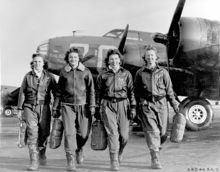 Frances Green, Margaret (Peg) Kirchner, Ann Waldner and Blanche Osborn leaving their plane, "Pistol Packin' Mama," at the four-engine school at Lockbourne AAF, Ohio, during WASP ferry training B-17 Flying Fortress
Frances Green, Margaret (Peg) Kirchner, Ann Waldner and Blanche Osborn leaving their plane, "Pistol Packin' Mama," at the four-engine school at Lockbourne AAF, Ohio, during WASP ferry training B-17 Flying Fortress
Battle for militarization
The WASP were civil service employees and did not receive military benefits, unlike their male counterparts.[5] On the other hand, they were not administratively tied to the Army Air Forces and could resign at any time after completion of their training, although few if any did.[citation needed]
On 30 September 1943 the first of the WASP militarization bills was introduced in the United States House of Representatives. Both Cochran and Arnold desired a separate corps headed by a woman colonel (similar to the WAC, WAVES, SPAR, and Marine heads). The War Department, however, consistently opposed such a move, since there was no separate corps for male pilots as distinguished from nonrated AAF officers. Instead, it preferred that women be commissioned in the WAC and thus added to some 2,000 "Air WAC" officers already assigned, for whom flying duty was then legally permissible.[citation needed]
On June 21, 1944, the bill in the House to give the WASP military status was narrowly defeated after civilian male pilots, reacting to closure of some civilian flight training schools and termination of two male pilot training commissioning programs, lobbied against the bill. The House Committee on the Civil Service (Ramspeck Committee) reported on June 5, 1944, that it considered the WASP was unnecessary, and unjustifiably expensive, and recommended that the recruiting and training of inexperienced women pilots be halted.[citation needed]
Cochran had been pushing for a resolution of the question, in effect delivering an ultimatum to either commission the women or disband the program. The AAF had developed an excess of pilots and pilot candidates, and as a result, Arnold (who had been a proponent of militarization) ordered that the WASP be disbanded by December 20, 1944.[5] Arnold is quoted from a speech he delivered at Avenger Field in Sweetwater, Texas on December 7, 1944:
The WASP have completed their mission. Their job has been successful. But as is usual in war, the cost has been heavy. Thirty-eight WASP have died while helping their country move toward the moment of final victory. The Air Forces will long remember their service and their final sacrifice.[5]
At the conclusion of the WASP program there were 916 women pilots on duty with the AAF, with 620 assigned to the Training Command, 141 to the Air Transport Command, 133 to the numbered air forces in the Continental United States, 11 to the Weather Wing, 9 to the technical commands, and one to the Troop Carrier Command.[citation needed]
Legacy
All records of the WASP were classified and sealed for 35 years, so their contributions to the war effort were little known and inaccessible to historians. In 1975, under the leadership of Col. Bruce Arnold, son of General Hap Arnold, the WASPs fought the "Battle of Congress" in Washington, D.C., to belatedly obtain recognition as veterans of World War II. They organized as a group again and tried to gain public support for their official recognition. Finally, in 1977, the records were unsealed after an Air Force press release erroneously stated the Air Force was training the first women to fly military aircraft for the U.S.[15]
This time, the WASPs lobbied Congress with the important support of Senator Barry Goldwater, who himself had been a World War II ferry pilot in the 27th Ferry Squadron. President Jimmy Carter signed legislation #95-202, Section 401, The G.I. Bill Improvement Act of 1977, granting the WASP corps full military status for their service. In 1984, each WASP was awarded the World War II Victory Medal. Those who served for more than one year were also awarded American Theater Ribbon/American Campaign Medal for their service during the war. Many of the medals were accepted by the recipients' sons and daughters on their behalf.[citation needed]
Because of the pioneering and the expertise they demonstrated in successfully flying military aircraft, the WASP pilots' record showed that women pilots, when given the same training as men pilots, were as capable as men in non-combat flying.[citation needed]
On July 1, 2009 President Barack Obama and the United States Congress awarded the WASP the Congressional Gold Medal. Three of the roughly 300 surviving WASPs were on hand to witness the event. During the ceremony President Obama said, "The Women Airforce Service Pilots courageously answered their country's call in a time of need while blazing a trail for the brave women who have given and continue to give so much in service to this nation since. Every American should be grateful for their service, and I am honored to sign this bill to finally give them some of the hard-earned recognition they deserve."[16] On March 10, 2010, 200 surviving WASPs came to the US Capitol to accept the Congressional Gold Medal from House Speaker Nancy Pelosi and other Congressional leaders.[17]
Notable WASP aviators
- Mildred Darlene "Micky" Tuttle Axton — A licensed pilot since 1940 (the only woman in her flight class at Coffeyville, Kan., Junior College), she was a member of WASP 43-W-7, but left the organization in April 1944 when her mother became ill. Micky at that time applied for a job with Boeing and was hired as a flight test engineer, in May 1944 becoming the first woman ever to fly the B-29 Superfortress. The Jayhawk Wing of the Commemorative Air Force operates a restored Fairchild PT-19 dubbed "Miss Micky" in her honor. Micky's brother, Ralph Tuttle, was an Army Air Corps fighter pilot in the Pacific Theater of Operations, earning the Silver Star and twice being awarded the Distinguished Flying Cross.
- Ann Baumgartner Carl [18]
- Jacqueline Cochran — Director of the WASP. In 1938, Cochran became famous nationwide for winning the Bendix Transcontinental Race.
- Rosa Charlyne Creger [19]
- Nancy Batson Crews [20]
- Cornelia Fort — One of the original WAFS. Fort's experience included evading Japanese attacking planes at Pearl Harbor on December 7, 1941.
- Violet Cowden
- Maggie Gee one of only two Asian-Americans in the WASP, the other being Hazel Ying Lee
- Betty Gillies
- Lois Hailey [21]
- Sara Payne Hayden
- Celia Hunter
- Marge Hurlburt — Held the woman's international airspeed record before her death in 1947.[22]
- Teresa James [23]
- Shirley C. Kruse
- Hazel Ying Lee, one of two Asian-Americans in the WASP, the other being Maggie Gee.
- Barbara Erickson London — Was the only WASP member to be awarded the Air Medal during World War II.[24] Following the war, medals were awarded to other WASP members.
- Nancy Love
- Annabelle Craft Moss
- Anne Noggle — Following the war she became a noted photographer and writer.[25]
- Suzanne Upjohn DeLano Parish, co-founder of Kalamazoo Air Museum.[26]
- Deanie Bishop Parrish [27]
- Mabel Rawlinson [28]
- Ola Mildred Rexroat, an Oglala Sioux from Pine Ridge Indian Reservation, South Dakota, was the only Native American woman in the WASP.[29]
- Margaret Ringenberg
- Gloria Heath [30]
- Dawn Rochow Seymour [31]
- Evelyn Sharp—In 1938, Evelyn Sharp was the youngest person in the United States to receive a commercial pilots license.[32]
- Helen "Skip" Sigler
- Gertrude Tompkins Silver — the last WASP to go missing in World War II. She made a flight from Mines Field (currently LAX) to Palm Springs on October 26, 1944, intending to fly a P-51 Mustang on to New Jersey, but never arrived in Palm Springs. As of Jan. 2010, search efforts to locate the crash site are still ongoing.[33][34]
- Dora Dougherty Strother [35]
- Ginny Hill Wood
- Carla Horowitz [36]
Fictional depiction
- Season 1, Episode 22 of Baa Baa Black Sheep was entitled W*A*S*P*S. It first aired on 1 March 1977. The episode was factually inaccurate, the WASP never flew overseas, and there is no "s" at the end of the name, since the name itself is plural.
- In the modern Wonder Woman continuity, Steve Trevor's mother, Diana Trevor, was a WASP who inadvertently crashlanded on Themyscira on a mission in the 1940s and died helping the Amazons fight an attacking menace.
- The 2008 TV movie Warbirds features a WASP B-29 crew whose plane is commandeered for a secret mission but crashes on a pteranodon-infested island.[37]
- A 2009 episode of the TV show Cold Case features the investigators looking for the murderer of a WASP after her plane is found in modern day Philadelphia.
See also
- Air Transport Auxiliary (ATA - British)
- Women Airforce Service Pilots Badge
- Women's Auxiliary Air Force (WAAF – British)
- Women's Auxiliary Australian Air Force (WAAAF)
- Royal Canadian Air Force Women's Division (RCAFWD)
- Women's Army Corps (WAC)
- Women in the Air Force (WAF)
References
- ^ a b [1]
- ^ [2]
- ^ [3]
- ^ "Women Ferrying Pilots - Requirements for Hiring - Pearl Harbor Filing Cabinet". Liberty Letters. 1942-09-15. http://www.libertyletters.com/resources/pearl-harbor/women-ferrying-pilots.php. Retrieved 2010-07-10.
- ^ a b c d e f Jacqueline Cochran and the Women's Airforce Service Pilots (WASPs)
- ^ http://thune.senate.gov/public/index.cfm?FuseAction=PressReleases.Detail&PressRelease_id=026b5888-86e0-4688-a4fc-e9e680ea96e4&Month=5&Year=2009
- ^ a b "In Pursuit of a Dream"
- ^ [4]
- ^ Rickman, Sarah Byrn (2001). The Originals - The Women's Auxiliary Ferrying Squadron of World War II. Sarasota, FL: Disc-Us Books. ISBN 1-58444-263-8. http://www.sarahbyrnrickman.com/books_originals.asp.
- ^ Granger, Byrd Howell (1991). On Final Approach. Scottsdale, AZ: Falconer Publishing. p. 90. ISBN 0-9626267-0-8.
- ^ Granger, Byrd Howell (1991). On Final Approach. Scottsdale, AZ: Falconer Publishing. pp. 70–121. ISBN 0-9626267-0-8.
- ^ Hope, Virginia M. Virginia Hope Papers: Folder 1. 1942-44. Raw data. Minnesota Historical Society Library, St. Paul.Many Helpful Primary Source Letters, Stats., Lists, ect.
- ^ Victoria Pope "Flight of the WASP," American Heritage, Spring 2009.
- ^ Bohn, Kevin (2009-05-22). "Unsung heroes of World War II finally get their due". CNN. http://www.cnn.com/2009/POLITICS/05/22/woman.pilots/.
- ^ Gomez, Mark (July 21, 2009). "S.J. woman was a trailblazing pilot during World War II". San Jose Mercury News. http://www.mercurynews.com/news/ci_12882187. Retrieved 22 July 2009.
- ^ WASP awarded Congressional Gold Medal for service
- ^ Female WWII aviators honored with gold medal
- ^ "Factsheets : Unknown Fact Sheet". Nationalmuseum.af.mil. http://www.nationalmuseum.af.mil/factsheets/factsheet.asp?id=1531. Retrieved 2010-07-10.
- ^ "Charlyne Creger, WASP". Wingsacrossamerica.us. http://wingsacrossamerica.us/web/creger.htm. Retrieved 2010-07-10.
- ^ "Factsheets : Unknown Fact Sheet". Nationalmuseum.af.mil. http://www.nationalmuseum.af.mil/factsheets/factsheet.asp?id=1526. Retrieved 2010-07-10.
- ^ "Lois E. Hailey - An Aviatrix from WWII". Wwii-women-pilots.org. http://wwii-women-pilots.org/lbhailey43-3/lbhailey.html. Retrieved 2010-07-10.
- ^ "Marge Hurlburt Is Killed While Stunting In Air Show". St. Petersburg Times. July 5, 1947. http://news.google.com/newspapers?id=Ib0KAAAAIBAJ&sjid=304DAAAAIBAJ&pg=6109,1451195&dq=airshow+crash. Retrieved 12 July 2009.
- ^ "Factsheets : Unknown Fact Sheet". Nationalmuseum.af.mil. http://www.nationalmuseum.af.mil/factsheets/factsheet.asp?id=1553. Retrieved 2010-07-10.
- ^ "Barbara Erickson London". Fact Sheets. National Museum of the Air Force. http://www.nationalmuseum.af.mil/factsheets/factsheet.asp?id=1539. Retrieved 15 July 2009.
- ^ "Anne Noggle WASP 44-W-1". Wings Across America. August 23, 2005. http://wingsacrossamerica.us/web/noggle_anne.htm. Retrieved 15 July 2009.
- ^ "Sue Parish". Air Zoo of Kalamazoo, Michigan. http://www.airzoo.org/page.php?page_id=111. Retrieved 13 September 2010.
- ^ "WASP Deanie Bishop Parrish". Wingsacrossamerica.us. http://www.wingsacrossamerica.us/deanie.htm. Retrieved 2010-07-10.
- ^ "Fallen Hero: Fly Girl from Kalamazoo". Everyday Citizen. 2007-05-28. http://www.everydaycitizen.com/2007/05/my_aunt_mabel_my_hero.html. Retrieved 2010-07-10.
- ^ http://www.defense.gov/specials/nativeamerican01/women.html
- ^ Briggs, John. A Singular Woman. Greenwich. July/August 1999.
- ^ [5][dead link]
- ^ "Evelyn Sharp". Nebraska Aviation Hall of Fame. Nebraska.gov. http://www.aero.state.ne.us/Sharp.htm. Retrieved 15 July 2009.
- ^ Ongoing Search For Mrs. Gertrude Tompkins Silver. Aircraft Wrecks in the Mountains and Deserts of the American West.
- ^ "Search Underway for Missing Heroine of World War II and her P-51 Mustang | Scuba Diving Magazine". Scubadiving.com. http://www.scubadiving.com/news/2009/09/search-underway-for-missing-heroine-of-world-war-ii-and-her-p-51-mustang. Retrieved 2010-07-10.
- ^ "Factsheets : Unknown Fact Sheet". Nationalmuseum.af.mil. http://www.nationalmuseum.af.mil/factsheets/factsheet.asp?id=1536. Retrieved 2010-07-10.
- ^ "Digital Collections : Item Viewer". Twudigital.cdmhost.com. 2005-02-07. http://twudigital.cdmhost.com/cdm4/item_viewer.php?CISOROOT=/p214coll2&CISOPTR=3768&CISOBOX=1&REC=1. Retrieved 2010-07-10.
- ^ Warbirds at the Internet Movie Database
Further reading
- Cole, Jean Hascall. Women Pilots of World War II. (University of Utah Press, 1992). ISBN 978-0-87480-493-5.
- Granger, Byrd Howell. On Final Approach: The Women Airforce Service Pilots of W.W.II. Falconer Publishing Co., 1991.
- Haynsworth, Leslie, and David Toomey. Amelia Earhart's Daughters. William Morrow and Company, 1998.
- Keil, Sally Van Wagenen, Those Wonderful Women in Their Flying Machines: The Unknown Heroines of World War II. New York: Four Directions Press, 1990. ISBN 0-9627659-0-2.
- Merryman, Molly. Clipped Wings: The Rise and Fall of the Women Airforce Service Pilots (WASPs) of World War II. New York: New York University Press, 1998. ISBN 0814755682.
- Noggle, Anne. For God, Country and the Thrill of It: Women Airforce Service Pilots During WWII. Texas A&M University Press. 1990
- Rickman, Sarah Byrn. Nancy Batson Crews: Alabama's First Lady of Flight. University of Alabama Press. 2009
- Rickman, Sarah Byrn, and Deborah G. Douglas . Nancy Love and the WASP Ferry Pilots of World War II (North Texas Military Biography and Memoir Series, 2008)
- Schrader, Helena. Sisters in Arms: British and American Women Pilots During World War II. Pen and Sword Books, 2006.
- Simbeck, Rob. Daughter of the Air: The Brief Soaring Life of Cornelia Fort. Atlantic Monthly Press. 1999.
- Strebe, Amy Goodpaster. Flying for her Country: The American and Soviet Women Military Pilots of World War II. Potomac Books. 2009
- Williams, Vera S. WASPs: Women Airforce Service Pilots of World War II. Osceola, Minnesota: Motorbooks International, 1994. ISBN 0-87938-856-0.
Primary sources
- Clark, Marie Mountain. Dear Mother and Daddy: World War II Letters Home from a WASP. Livonia MI: First Page Publications, 2005. ISBN 1-928623-63-8.
- Parrish, Nancy. WASP In Their Own Words--An Illustrated History of the Women Airforce Serivce Pilots.Texas: Wings Across America Publications, 2010. ISBN 978-0-970345004.
External links
- The UNCG Betty H. Carter Women Veterans Historical Project: Air Force (incl WAF, WASP, Nurse Corps)
- Women in the U.S. Army
- USAF Museum: Women Pilots in World War II History—Air Force Museum virtual exhibit.
- WASP Awarded Congressional Gold Medal, March 10, 2010
- PBS American Experience: Fly Girls Website for the PBS documentary on the WASP.
- WASP on the WEB over 2,000 pages of WASP photos, games, videos, records and resources
- Texas Woman's University: Women Airforce Service Pilots Collection TWU maintains the official WASP archives and includes oral histories, photographs, and other archival collections on the WASP.
- Wings Across America; a WASP digital history project
- WASP in their Own Words, An Illustrated History of the WASP of WWII
- Women Airforce Service Pilots (WASP) Remembered by those who knew them
- The National WASP World War II Museum
- Nancy Love and the WASP Ferry Pilots of World War II
- Blitzkrieg Baby—Information on World War II U.S. women's service organizations, including uniforms.
- Winged Auxiliaries: Women Pilots in the UK and US during World War Two—Draws comparisons between British ATA and American WASP pilots in World War II.
- Dwight D. Eisenhower Presidential Library's archives—information and documentation about the WASPs and Jacqueline Cochran.
- The account of the discovery of the site of a B-25 crash which killed a WASP pilot; some of her effects were found.
National Museum of the USAF fact sheets
- WASPS: Breaking Ground for Today's Female USAF Pilots
- Women's Auxiliary Ferry Squadron
- Nancy Harkness Love Biography
- Description of Fifinella from USAF website
- WASPS Demonstrate their Abilities
- WASP Disbanded
- WASP Epilogue
- Women Pilots with the AAF, 1941–1944
United States in World War II Home Front American music during World War II • United States aircraft production during World War II • Greatest Generation
American WomenWomen Airforce Service Pilots • Women's Army Corps• Woman's Land Army of America • Rosie the RiveterMilitary participation Army (Uniforms) • Army Air Force • Marine Corps • Navy • Service medals (Medal of Honor recipients)
EventsList of Battles • Attack on Pearl Harbor • Normandy landings • Atomic bombings of Hiroshima and NagasakiMinoritiesDiplomatic participation Categories:- All-female military units and formations
- American aviators
- Congressional Gold Medal recipients
- Female aviators
- Women Airforce Service Pilots
- Women in the United States military
- Women in World War II
Wikimedia Foundation. 2010.

